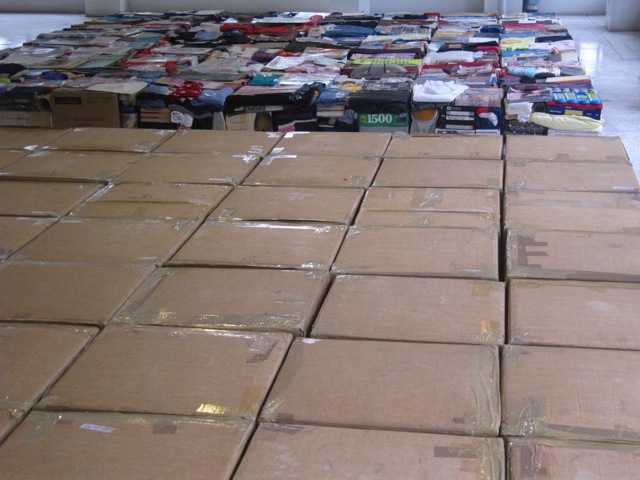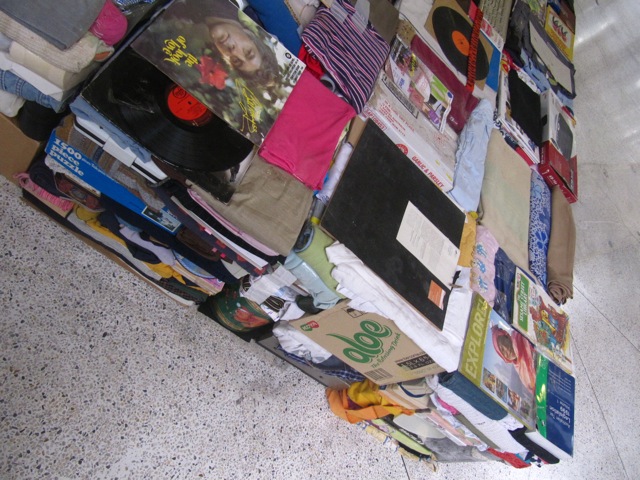What continues to surprise about the couple Alfredo and Isabel Aquilizan’s work is that even as they have become familiar, they still fascinate; even as the forms and structures are old which is to say ones you’ve seen before, it allows still for an echo that surprises you as spectator, one that stays with you weeks after seeing the work. In Address, the Aquilizans continue work that revolves around the concept of the balikbayan box as a symbol of movement and transience, the manner in which people’s lives are packed up into boxes, only to be unpacked elsewhere distant.

A sea of memory and displacement in "Address" by Alfredo and Isabel Aquilizan
Here, 64 balikbayan boxes, eight rows of eight, are installed side-by-side on the floor, forming an expanse of brown cardboard gleaming in parts with packing tape. Beside it, in the same size and shape, are the objects formed by and within these boxes, in 64 distinct cubes, that meld together into an expanse of things packed tightly together, even as delineations from one cube to the next are sharp, and objects maintain their individuality. It’s in the latter that one cannot help but be captured by
Address, as it is towards the latter that the spectator is drawn. These are after all familiar objects, even as they are defamiliarized by the manner in which they’re packed. It’s in this sense that these cubed objects, while seemingly random, also carry a deliberateness to them. So that while on the one hand the assemblage of these objects into cubes seems chaotic, on the other what it reveals and conceals proves a careful process of packing, so to speak. For there are layers of material that can easily be clothes and boxes among other unidentifiable objects deeply embedded into these cubes. But from beneath these layers it’s difficult to miss a smiling doll or a stuffed toy, books and a toy bus, old VHS tapes and a boom box, a kitchen strainer and a box of cognac, tightly packed small containers with things one cannot know. The surface that these boxes create is a veritable land of things we keep: various books, yes, but also a computer keyboard, a shoulder bag, an old record, a chess set, boardgames.

Old records, books, clothes, magazines meaningless and ephemeral, truth of selves in constant flux
The randomness of these objects is precisely its meaninglessness. As part of the chaos in these cubes, created as these are from within boxes that are about movement and migration, it can only reverberate with meaning. Because objects tie us to home, the things we carry are about the self we want to keep. Where there is no packing lightly when objects come to represent who we are, where we’ve been, where we hope to go. Where the usefulness of objects becomes secondary to the task of keeping, if not holding tight, lest self and memory and meaning are lost in the act of leaving. But notions of migration –
not just movement – are carried by the balikbayan box itself as symbol, the box from which these objects sprout. It’s in that way that these objects, while representative of what keeps people tied to spaces and selves left behind, is also about how many lives are rendered ephemeral and transient, in constant flux, in an ongoing process of coming and going. In that sense, these objects’ meanings cannot but change, rendering stability untrue, putting a spotlight on the ideas that surround migration as a gift to nation. Because these objects
are about home. This one from which we come, this one that has made a business out of letting its people go, sacrificing families and children’s upbringing, putting into question truths of completeness and normalcy. Because migration is always a form of leaving, and when the balikbayan boxes are symbols of it, it is also always about accumulation for sending back home: it’s
for the left behind, instead of about the one who leaves. In
Address though these things aren’t new, aren’t about bringing something home, aren’t about those left behind, as they are about the ones who up and leave, out of need and sacrifice and urgency. Here is the sadness in
Address, and here is how it maintains interest and resonance. It reminds one not just of the temporariness of home, but even more so of selves unhinged, un-grounded, ultimately lost – the people we’ve lost – to the fact of migration. -
YA, GMA News Address ran at the Vargas Museum until the end of October 2011. 






